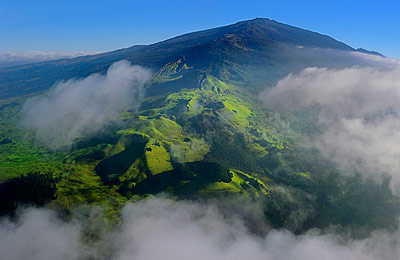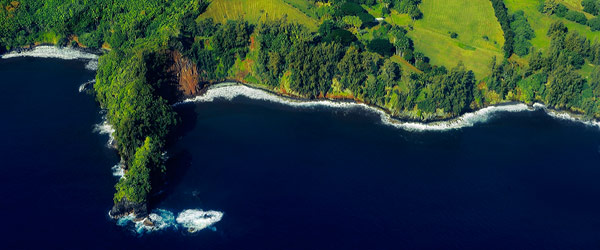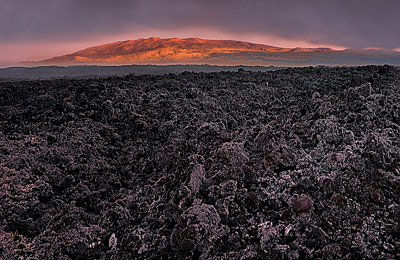Workshop at the Ranch – February 2010 – The D3s Advantage
![]() Hi and welcome to this edition of Workshop at the Ranch. My January article kicked off the New Year with an in-depth review of the NEW Nikon D3s camera. The response from readers was terrific with many of you requesting additional images and commentary. Well, as P.T. Barnum said, “Give the people what they want.” Here is a continuation of my D3s review, but rather than examine grid iron imagery, this time I thought we would see what advantages the New Nikon D3s camera offers in some other, more hospitable environments.
Hi and welcome to this edition of Workshop at the Ranch. My January article kicked off the New Year with an in-depth review of the NEW Nikon D3s camera. The response from readers was terrific with many of you requesting additional images and commentary. Well, as P.T. Barnum said, “Give the people what they want.” Here is a continuation of my D3s review, but rather than examine grid iron imagery, this time I thought we would see what advantages the New Nikon D3s camera offers in some other, more hospitable environments.
Hi and welcome to this edition of Workshop at the Ranch. My January article kicked off the New Year with an in-depth review of the NEW Nikon D3s camera. The response from readers was terrific with many of you requesting additional images and commentary. Well, as P.T. Barnum said, “Give the people what they want.” Here is a continuation of my D3s review, but rather than examine grid iron imagery, this time I thought we would see what advantages the New Nikon D3s camera offers in some other, more hospitable environments.
|
|
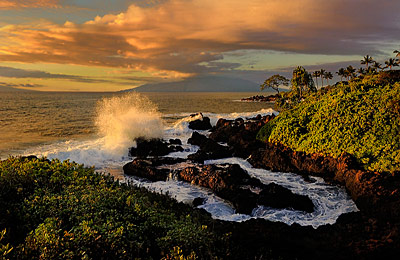 Image #2 Coastal Glow … The western Maui coastline is beautiful at sunset. The southwest end of the island near Wailea provided some wonderful scenic opportunities for classic tropical island images. The color of light that comes with the final rays of a setting sun can be beautiful. Trouble is, at this time of evening the amount of light is so diminished that it is difficult to have a fast enough shutter speed to freeze the action of the crashing ocean spray. The D3s advantage here is the noiseless high ISO4000. This high ISO setting not only gives me a shutter speed of 1/1250 which is enough to freeze the spraying water, but also allows me to use an aperture of f11 which gives a broad depth of field that keeps the entire coastline in focus. Nikon D3s, ISO4000, 1/1250 at f11, Nikon 24-70mm lens with a Formatt 3x Graduated Neutral Density Filter (GNDF), WB 6670K, Lexar 16G Flash Card. I placed the GNDF diagonally over the sky, ocean, and ocean spray to reduce the exposure, deepen the color of the clouds, and preserve the highlights of the white water spray. Image #2 Coastal Glow … The western Maui coastline is beautiful at sunset. The southwest end of the island near Wailea provided some wonderful scenic opportunities for classic tropical island images. The color of light that comes with the final rays of a setting sun can be beautiful. Trouble is, at this time of evening the amount of light is so diminished that it is difficult to have a fast enough shutter speed to freeze the action of the crashing ocean spray. The D3s advantage here is the noiseless high ISO4000. This high ISO setting not only gives me a shutter speed of 1/1250 which is enough to freeze the spraying water, but also allows me to use an aperture of f11 which gives a broad depth of field that keeps the entire coastline in focus. Nikon D3s, ISO4000, 1/1250 at f11, Nikon 24-70mm lens with a Formatt 3x Graduated Neutral Density Filter (GNDF), WB 6670K, Lexar 16G Flash Card. I placed the GNDF diagonally over the sky, ocean, and ocean spray to reduce the exposure, deepen the color of the clouds, and preserve the highlights of the white water spray. |
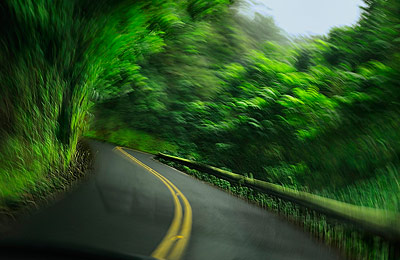 Image #3 Road to Hana … With many travel scenes on my docket I made the long and winding trek down the Hana Highway on the eastern side of the island. Full of spectacular views and waterfalls this serpentine roadway twists and turns, hour after hour on its way to the little town of Hana. With my wife Susan at the wheel I grabbed my D3s and made a few pictures between photo locations. By simultaneously rotating the camera counterclockwise, zooming in, and pressing the shutter button I believe I captured the true essence of the Hana Highway experience. Nikon D3s, ISO200, 1/8 sec. At f10, Nikon 24-70mm lens, 7140K, Lexar 16G Flash Card. Image #3 Road to Hana … With many travel scenes on my docket I made the long and winding trek down the Hana Highway on the eastern side of the island. Full of spectacular views and waterfalls this serpentine roadway twists and turns, hour after hour on its way to the little town of Hana. With my wife Susan at the wheel I grabbed my D3s and made a few pictures between photo locations. By simultaneously rotating the camera counterclockwise, zooming in, and pressing the shutter button I believe I captured the true essence of the Hana Highway experience. Nikon D3s, ISO200, 1/8 sec. At f10, Nikon 24-70mm lens, 7140K, Lexar 16G Flash Card. |
 Image #4 Honolua High Surf … There is no question that the New Nikon D3s camera is perfect for sports. And while most of my work in the Hawaiian Islands involved lovely scenic and travel imagery it did include some surfing as well. What a great sport! I can hardly think of a more pleasurable way to spend the day but to sit atop a cliff with a long lens and capture the action. Even though it is a bright sunny day I still chose a semi high ISO of 2000. This allows me two very distinct D3s advantages. First, with ISO2000 I can use an extremely fast shutter speed of 1/3200. This freezes every droplet of the Pacific Ocean that my athlete throws into the air and that blows off the crest of the wave. If I use 1/1000 the result is not the same. There is something about an ultra fast shutter speed that makes water sports like surfing look their best. Secondly, with ISO2000 I can also have a wide aperture setting of f13. With f13 I have a broad depth of field which keeps the entire scene in focus even with the use of a long lens. All this is accomplished without any noise issues even in the dark, almost silhouetted surfer. The combination of frozen action, everything being in perfect focus and no noise makes for spectacular imagery. Nikon D3s, ISO2000, 1/3200 at f13, Nikon 200-400mm G VR lens with Nikon 1.7x Teleconverter (totals a 650mm length,) WB 5560K, Lexar 16G Flash Card. Image #4 Honolua High Surf … There is no question that the New Nikon D3s camera is perfect for sports. And while most of my work in the Hawaiian Islands involved lovely scenic and travel imagery it did include some surfing as well. What a great sport! I can hardly think of a more pleasurable way to spend the day but to sit atop a cliff with a long lens and capture the action. Even though it is a bright sunny day I still chose a semi high ISO of 2000. This allows me two very distinct D3s advantages. First, with ISO2000 I can use an extremely fast shutter speed of 1/3200. This freezes every droplet of the Pacific Ocean that my athlete throws into the air and that blows off the crest of the wave. If I use 1/1000 the result is not the same. There is something about an ultra fast shutter speed that makes water sports like surfing look their best. Secondly, with ISO2000 I can also have a wide aperture setting of f13. With f13 I have a broad depth of field which keeps the entire scene in focus even with the use of a long lens. All this is accomplished without any noise issues even in the dark, almost silhouetted surfer. The combination of frozen action, everything being in perfect focus and no noise makes for spectacular imagery. Nikon D3s, ISO2000, 1/3200 at f13, Nikon 200-400mm G VR lens with Nikon 1.7x Teleconverter (totals a 650mm length,) WB 5560K, Lexar 16G Flash Card. |
|
Image #5 Kukui Point … This is a panorama made up of 2 images merged (stitched) together in Photoshop to form one file. If you are not familiar with this process please check out my May 2008 Workshop at the Ranch article “Learn Something New.” Flying over the Big Island’s Hamakua coastline provided some beautiful aerial landscapes. Even though the D3s is an upgrade from the D3 with regards to high ISO noise reduction let’s not forget the improved image quality. The 12.1 megapixel file contains more edge detail than ever. From the wave ripples in the Pacific Ocean to the leaves on the trees the improved file quality is a definite D3s advantage. Nikon D3s, ISO500, 1/1000 at f10, Nikon 24-70mm lens, WB 5560K, Lexar 16G Flash Card. |
|
|
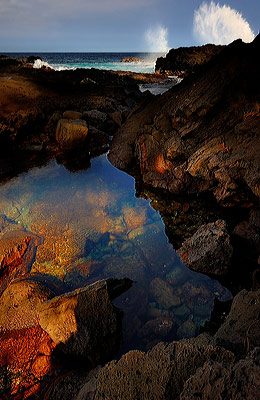 Image #7 Hilo Surf … The eastern coastline of the Big Island of Hawaii has some wonderful character and rugged beauty. This lava rock/tide pool area is only 20 minutes from the town of Hilo. With sections of this scene in deep shadow and other portions in bright sunshine I used two GNDF to control the light. I placed a 2x GNDF over the upper right corner of the frame to reduce the light on the ocean spray only. Then I used a 3x GNDF from the lower left corner to reduce the light on the sun-lit rocks and positioned it diagonally to the upper right corner were it also reduced light on the ocean spray. The dark lava rocks occupying the right side of the frame have the clear portion of the GNDF. The result is even density and a seemly perfect exposure throughout the entire image. The D3s advantage is the clean ISO3200. ISO3200 keeps the sun-lit areas free of any noise and keeps the deep shadowed areas nearly noiseless as well. The high ISO also allows me to “stack” the 2 GNDF and still have a fast enough shutter speed to freeze the ocean spray and have a broad depth of field via an aperture of f22. Nikon D3s, ISO3200, 1/500 at f22, Nikon 24-70mm lens, WB 6670K, Lexar 16G Flash Card. Sometimes it can be complicated to reproduce photographically what the extreme latitude of the human eye sees naturally. Image #7 Hilo Surf … The eastern coastline of the Big Island of Hawaii has some wonderful character and rugged beauty. This lava rock/tide pool area is only 20 minutes from the town of Hilo. With sections of this scene in deep shadow and other portions in bright sunshine I used two GNDF to control the light. I placed a 2x GNDF over the upper right corner of the frame to reduce the light on the ocean spray only. Then I used a 3x GNDF from the lower left corner to reduce the light on the sun-lit rocks and positioned it diagonally to the upper right corner were it also reduced light on the ocean spray. The dark lava rocks occupying the right side of the frame have the clear portion of the GNDF. The result is even density and a seemly perfect exposure throughout the entire image. The D3s advantage is the clean ISO3200. ISO3200 keeps the sun-lit areas free of any noise and keeps the deep shadowed areas nearly noiseless as well. The high ISO also allows me to “stack” the 2 GNDF and still have a fast enough shutter speed to freeze the ocean spray and have a broad depth of field via an aperture of f22. Nikon D3s, ISO3200, 1/500 at f22, Nikon 24-70mm lens, WB 6670K, Lexar 16G Flash Card. Sometimes it can be complicated to reproduce photographically what the extreme latitude of the human eye sees naturally. |
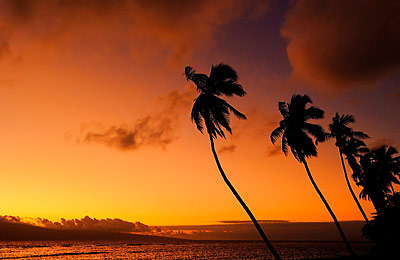 Image #8 Trade Winds … The D3s advantage continued with every picture I made. With trade winds blowing the palm trees one might give up and come back on a calm evening, but the D3s noiseless ISO2200 was the perfect solution. By correctly exposing for the brilliant sunset (lower left) the rest of the frame gradually and naturally fades to become underexposed. It is common knowledge that underexposed areas of a digital picture tend to show noise especially at high ISO settings. This is why it is so important for the photographer to make correct exposures in order to have noiseless images. By the way, this rule applies whether you use Nikon or Canon. But the D3s advantage is that it greatly eliminates noise in underexposed areas more efficiently than any other camera on the market today. Much of my work leans towards a sparing use of light with deep shadows and underexposed areas of the scene to create mood and drama. My Lightpaintings are a good example of this style. The D3s allows me to use the highest and cleanest ISO available in the industry. This is a big reason why I made the purchase of the New Nikon D3s. Nikon D3s, ISO2200, 1/250 at f6.3, Nikon 24-70mm lens, WB 8000K, Lexar 16G Flash Card. Image #8 Trade Winds … The D3s advantage continued with every picture I made. With trade winds blowing the palm trees one might give up and come back on a calm evening, but the D3s noiseless ISO2200 was the perfect solution. By correctly exposing for the brilliant sunset (lower left) the rest of the frame gradually and naturally fades to become underexposed. It is common knowledge that underexposed areas of a digital picture tend to show noise especially at high ISO settings. This is why it is so important for the photographer to make correct exposures in order to have noiseless images. By the way, this rule applies whether you use Nikon or Canon. But the D3s advantage is that it greatly eliminates noise in underexposed areas more efficiently than any other camera on the market today. Much of my work leans towards a sparing use of light with deep shadows and underexposed areas of the scene to create mood and drama. My Lightpaintings are a good example of this style. The D3s allows me to use the highest and cleanest ISO available in the industry. This is a big reason why I made the purchase of the New Nikon D3s. Nikon D3s, ISO2200, 1/250 at f6.3, Nikon 24-70mm lens, WB 8000K, Lexar 16G Flash Card. |
There are many D3s advantages that I have tried to illustrate in these back-to-back articles. It is my hope that this information helps encourage those of you looking to make the purchase of a Nikon D3s and also helps you make better pictures once you have it.
Thanks again for joining me, and I’ll see you next time here on Workshop at the Ranch. A Hui Hou (until we meet again). Dave


